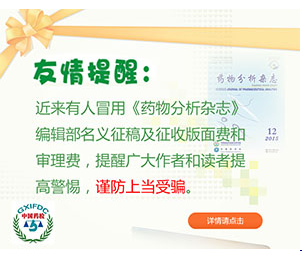|
期刊名称:药物分析杂志
主管单位:中国科学技术协会
主办单位:中国药学会承办:中国食品药品检定研究院
主编:金少鸿
地址:北京天坛西里2号
邮政编码:100050
电话:010-67012819,67058427 电子邮箱:ywfx@nifdc.org.cn
国际标准刊号:ISSN 0254-1793
国内统一刊号:CN 11-2224/R
邮发代号:2-237
|
毛橘红与光橘红的HPLC药效指纹图谱比较研究
A comparative study of HPLC pharmacodynamic fingerprints Maojuhong and Guangjuhong
作者:
王铁杰1,2,3,4, 宋茜1, 江坤2,3,4,5, 王平2,4, 殷果2,3,4, 谢天柱2, 吴熙2,3, 谢普1, 李璐1, 叶文才3,5, 王磊3,5
作者(英文):WANG Tie-jie1,2,3,4, SONG Qian1, JIANG Kun2,3,4,5, WANG Ping2,4, YIN Guo2,3,4, XIE Tian-zhu2, WU Xi2,3, XIE Pu1, LI Lu1, YE Wen-cai3,5, WANG Lei3,5
单位(英文):1. School of Pharmacy, Shenyang Pharmaceutical University, Shenyang 110016, China;
2. Shenzhen Institute for Drug Control, Shenzhen 518057, China;
3. Shenzhen Engineering Laboratory of Exploitation and Utilization of Medicinal Material Resources in Lingnan, Shenzhen 518057, China;
4. Shenzhen Key Laboratory of Drug Quality Standard Research, Shenzhen 518057, China;
5. Institute of Traditional Chinese Medicine & Natural Products, Jinan University, Guangzhou 510632, China
分类号:
出版年·卷·期(页码):2014,34 (5):0-0
DOI:
10.16155/j.0254-1793.2017.01.01
-----摘要:-------------------------------------------------------------------------------------------
目的:建立能代表毛橘红与光橘红止咳、祛痰、抗炎药效的HPLC指纹图谱,并比较两者的差异。方法:采用小鼠氨水引咳法、酚红排泄法和二甲苯致耳肿胀法对毛橘红和光橘红进行止咳、祛痰和抗炎作用研究。采用HPLC法建立指纹图谱。色谱柱为Shiseido Capcell Pak C18色谱柱(4.6 mm×250 mm,5 μm);流动相为甲醇(A)-0.5%醋酸水溶液(B),二元梯度洗脱(0 min,10%A→20%A;10 min,20%A→40%A;30 min,40%A→49%A;85 min,49%A→90%A);检测波长为320 nm;柱温为30 ℃;流速为1.0 mL·min-1。分别采用“中药色谱指纹图谱相似度评价系统(2012.1版本)”和SPSS 17.0对谱图进行相似度分析和聚类分析。结果:毛橘红与光橘红70%乙醇提取物均具有止咳、祛痰和抗炎作用,毛橘红优于光橘红。毛橘红与光橘红的指纹图谱分别有18和17个共有峰,从对照指纹图谱和聚类分析结果看,两者存在明显差异。结论:建立了基于药效的毛橘红与光橘红70%乙醇提取物的HPLC指纹图谱,该分析方法专属、灵敏、准确,为毛橘红与光橘红的鉴别及该药品有效性质量控制提供参考。毛橘红与光橘红药效成分指纹图谱差异显著,质量标准中可以分别建立毛橘红和光橘红的指纹图谱的检测。
-----英文摘要:---------------------------------------------------------------------------------------
Objective: To establish the HPLC fingerprints of Maojuhong and Guangjuhong which can represent the action of antitussive,expectorant and anti-inflammatory effects,and to find the difference between the two fingerprints. Methods: The cough model induced by ammonia liquor in mice,the expectorant model induced by phenol red excretion in mice,the inflammatory model of ear edema induced by dimethyl benzene in mice were used to observe the antitussive,expectorant and anti-inflammatory effects of Maojuhong and Guangjuhong.Samples were extracted with 70% ethanol aqueous and then separated on the Shiseido Capcell Pak C18 column(4.6 mm×250 mm,5 μm).Gradient elution(0 min,10%A→20%A;10 min,20%A→40%A;30 min,40%A→49%A;85 min,49%A→90%A) was carried out with a mobile phase of methanol and 0.5% acetate acid aqueous.The detection wavelength was 320 nm;the column temperature was set at 30 ℃;the flow rate was 1.0 mL·min-1.The software "Similarity Evaluation System for Chromatographic Fingerprint of TCMs(Version 2012.1)" was employed to generate the mean chromatogram and carry out the similarity analysis of the samples.SPSS 17.0 was employed to carry out the cluster analysis. Results: Both Maojuhong and Guangjuhong had antitussive,expectorant and anti-inflammatory effects,but the former was better than the latter. There were 18 common peaks in HPLC fingerprints of Maojuhong and 17 common peaks in that of Guangjuhong.Their HPLC standard fingerprints were obviously different according to fingerprinting and cluster analysis. Conclusion: The HPLC fingerprints were established based on pharmacodynamic effects.The method was selective,sensitive and accurate.The method provided reference for the identification of Maojuhong and Guangjuhong,and the quality control of drug efficacy.As the significant differences existed in the pharmacodynamic fingerprints between Maojuhong and Guangjuhong,the detection of fingerprints could be established respectively in quality standards of Maojuhong and Guangjuhong.
-----参考文献:---------------------------------------------------------------------------------------
欢迎阅读《药物分析杂志》!您是该文第 866位读者!
|




